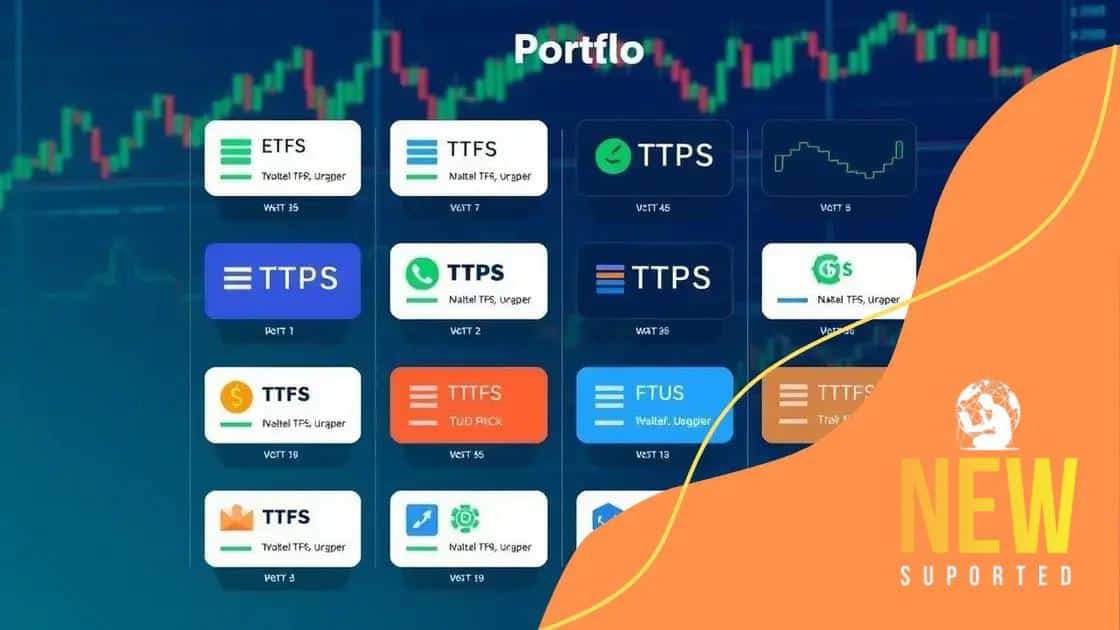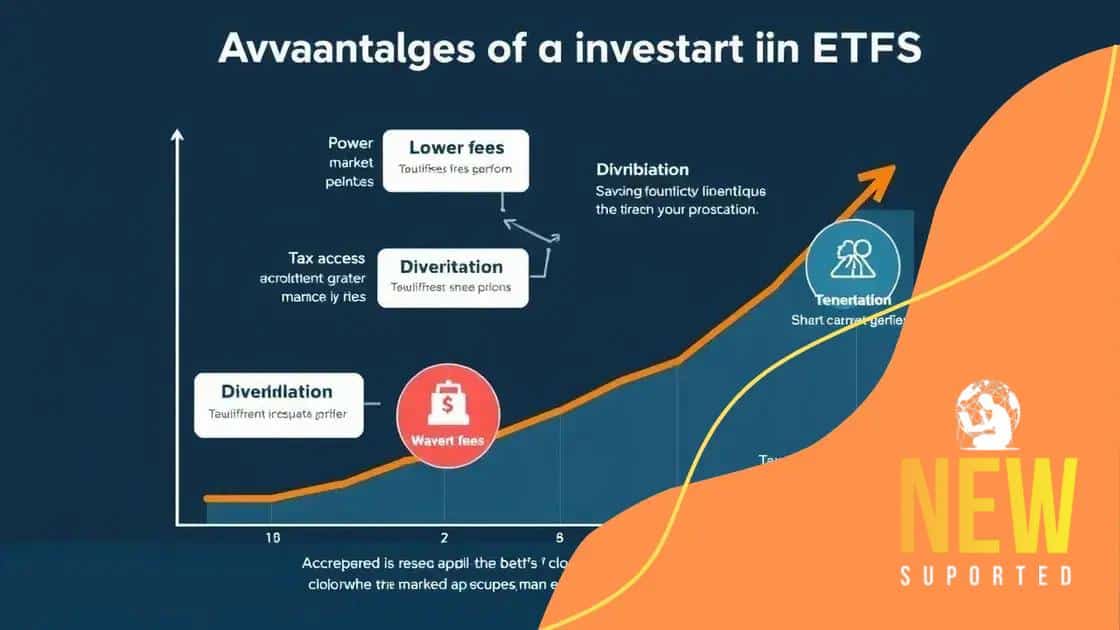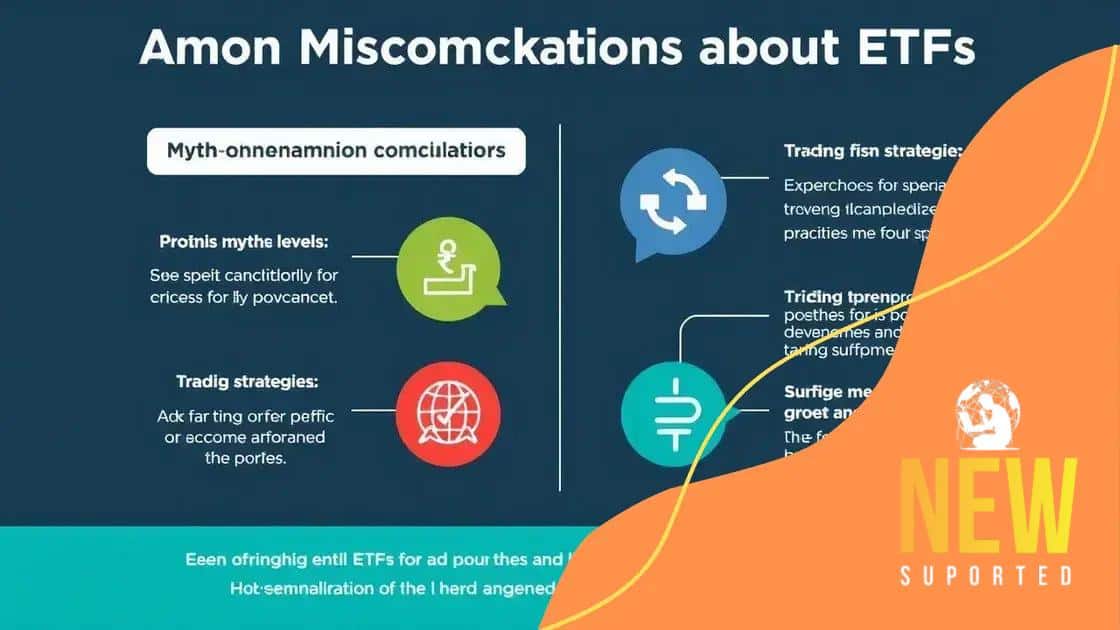Why ETFs are becoming popular investment vehicles

ETFs are popular investment vehicles due to their low fees, diversification, flexibility for both short and long-term investments, and the availability of various types, including thematic and ESG options.
Why ETFs are becoming popular investment vehicles? If you’ve noticed a shift in how people invest lately, it’s likely due to the rise of ETFs. These funds offer unique benefits that appeal to both novice and experienced investors alike.
Understanding ETFs: What Are They?
Understanding ETFs is crucial for anyone looking to navigate the investment landscape. ETFs, or Exchange Traded Funds, are investment funds that trade on stock exchanges, similar to stocks. This structure allows investors to buy and sell them throughout the trading day at market prices.
The flexibility of ETFs makes them a popular choice among investors. Unlike mutual funds, which are only traded at the end of the trading day, ETFs provide real-time pricing. This feature allows investors to capitalize on market fluctuations quickly.
Key Features of ETFs
There are several important characteristics of ETFs that set them apart from other investment options:
- Diversification: ETFs often hold a diverse range of stocks or bonds, which can help spread risk.
- Low fees: Generally, ETFs have lower expense ratios compared to mutual funds, making them a cost-effective choice.
- Tax efficiency: Due to their unique structure, ETFs typically generate fewer capital gains taxes.
Investors are increasingly drawn to ETFs because they combine diversification with flexibility. Furthermore, ETFs can represent various asset classes ranging from stocks and bonds to commodities and real estate.
Another appealing aspect of ETFs is their transparency. Most ETFs disclose their holdings on a daily basis, helping investors make informed decisions. This level of transparency is often missing in mutual funds, where investors typically must wait for quarterly updates.
The Different Types of ETFs
ETFs can be categorized based on their holdings or the strategy they follow:
- Stock ETFs: These funds track specific indices or sectors.
- Bond ETFs: These provide exposure to various types of bonds, like government or corporate bonds.
- Commodity ETFs: These track the price of physical commodities such as gold or oil.
- Sector and Industry ETFs: These focus on specific sectors of the economy, such as technology or healthcare.
In summary, understanding what ETFs are and their various features is key to making informed investment choices. Their combination of low fees, diversification, and transparency makes them an attractive option for many investors.
Key advantages of investing in ETFs

Investing in ETFs comes with several key advantages that can benefit both new and experienced investors. One significant reason many people choose ETFs is their diversification. By investing in an ETF, you can hold a variety of assets – like stocks, bonds, or commodities – which helps spread out risk.
When it comes to costs, ETFs typically have lower fees compared to mutual funds. This means that more of your money stays invested rather than going toward expenses. Moreover, many ETFs follow a passive investment strategy, which can be more cost-effective than actively managed funds.
Tax Efficiency
Another important advantage is the tax efficiency of ETFs. Because they generally realize fewer capital gains, investors are less likely to face a hefty tax bill. This feature makes them attractive for those looking to maximize their returns and minimize tax liabilities.
The flexibility of trading is another attractive aspect of ETFs. You can purchase or sell shares anytime during market hours, making it easy to react to market changes without delay. This ability to trade like stock gives investors more control over their investments.
Accessibility and Variety
ETFs are also incredibly accessible. Most brokers allow you to invest in ETFs with little to no minimum investment, making them a good choice for those just starting out. Additionally, the variety of ETFs available can cater to many investment strategies, including growth, value, and income investing.
Investing in ETFs allows for greater transparency. Most ETFs disclose their holdings daily, which enables investors to see exactly what they own. This level of transparency contrasts with some mutual funds, which only report their holdings quarterly.
These advantages make ETFs an increasingly popular choice among investors seeking a straightforward and effective way to grow their portfolios.
How to invest in ETFs effectively
Investing in ETFs effectively requires understanding how these financial instruments work. First, it’s essential to do your research. Identify the ETFs that match your investment goals and risk tolerance. Look for funds that align with your broader financial plan.
One of the first steps is to examine the holdings of an ETF. This provides insight into what assets you will own. Check the fund’s performance history, fees, and management style. Understanding these factors can guide you in choosing the right fund for your needs.
Building a Diversified Portfolio
A key principle in effective ETF investing is building a well-diversified portfolio. This means investing in various asset classes to spread risk. Consider including different sectors, regions, and investment styles. Diversification can help smooth out returns and reduce the impact of market volatility.
Next, determine your investment strategy. Are you looking for growth, income, or a blend of both? Your strategy should reflect your financial objectives. For example, a growth-focused approach might lead you to invest in ETFs that track technology stocks, while an income-focused strategy may involve dividend-paying ETFs.
Timing Your Investments
Timing can also be crucial when investing in ETFs. Consider dollar-cost averaging, where you invest a fixed amount regularly. This method takes the guesswork out of timing the market and can help mitigate the effects of market fluctuations. Additionally, monitor market trends and economic indicators that might impact ETF prices.
Review your holdings periodically. The performance of different ETFs may vary over time, requiring adjustments to your portfolio. Rebalancing ensures that your asset allocation remains aligned with your investment goals.
Lastly, consider your exit strategy. Know when to sell and what conditions would prompt you to shift your investments. Having a plan for exiting the market can reduce emotional decision-making and enhance your overall effectiveness as an investor.
Common misconceptions about ETFs

Many investors have misconceptions about ETFs that can lead to confusion or missed opportunities. One common belief is that ETFs are too risky. While any investment carries some risk, ETFs provide built-in diversification. This feature helps distribute risk across multiple assets, making them less volatile than individual stocks.
Another misconception is that all ETFs have high fees. In reality, many ETFs have lower expense ratios compared to actively managed mutual funds. Investors should do their homework to find cost-effective options that fit their needs.
ETFs Are Only for Day Traders
Some people think that ETFs are only suitable for active traders. However, they can be a valuable tool for long-term investors as well. Many ETFs track indices or sectors, making it easy to build a diversified portfolio without needing to trade frequently.
- Holding Period: Investors can hold ETFs for years, similar to stocks.
- Investment Strategy: They can be used to implement various strategies, including long-term growth.
- Retirement Accounts: ETFs can be included in IRAs and 401(k)s for retirement savings.
Some might believe all ETFs are the same, but the reality is much different. There are various types of ETFs, including equity, bond, sector, and commodity ETFs. Each type serves different investment goals and strategies. Investors should explore the differences to find the right fits.
ETFs Automatically Lead to Big Profits
Another common myth is that investing in ETFs guarantees profits. Like any investment, there are no guarantees. The performance of an ETF depends on the underlying assets it holds. It’s essential to conduct thorough research to understand what you’re investing in.
Finally, some believe that you cannot trade ETFs outside of market hours. This is incorrect; with certain brokers, investors can trade ETFs during extended hours. Learning the specific trading capabilities offered by your broker can provide more flexibility.
The future of ETFs in investment portfolios
The future of ETFs in investment portfolios looks promising as more investors recognize their benefits. As the market evolves, ETFs are becoming integral parts of diversified strategies. Their flexibility and transparency are appealing features that continue to draw interest from various types of investors.
One trend shaping the future of ETFs is the growth of thematic ETFs. These funds focus on specific trends or themes, such as renewable energy, technology innovation, or health care advancements. This development allows investors to capitalize on emerging markets and sectors they believe will perform well.
Increased Adoption by Institutions
Institutions are increasingly adopting ETFs as part of their asset allocation strategies. This shift is driven by the need for cost-effective solutions that can provide liquidity and diversification. Institutional investors are now leveraging ETFs to manage large portfolios more efficiently, which enhances market accessibility for individual investors as well.
- Liquidity: ETFs offer easy access to liquid markets.
- Diversification: They can hold a variety of assets, reducing individual stock risk.
- Cost-Effectiveness: Lower fees compared to traditional funds.
Another significant factor in the future of ETFs is the advancement of technology. Enhanced trading platforms and data analytics tools are making it more straightforward for investors to manage their ETF holdings. These innovations help users make informed decisions, tailoring their portfolios to their unique risk tolerances and investment goals.
Regulatory Changes
Regulatory environments are also evolving, which can positively impact ETFs. As regulations become more favorable, we may see increased transparency and reduced costs for investors. Regulatory bodies are continually assessing the ETF landscape to ensure fair trading practices and protect investors, which can foster further confidence in these investment vehicles.
Lastly, as new generations of investors become more concerned about sustainable and ethical investing, there is likely to be a surge in the popularity of ESG (Environmental, Social, and Governance) ETFs. These funds cater to investors looking to align their portfolios with their values, driving demand in a new direction.
FAQ – Frequently Asked Questions about ETFs
What are ETFs?
ETFs, or Exchange Traded Funds, are investment funds that trade on stock exchanges, similar to stocks.
Why are ETFs becoming popular?
ETFs are popular due to their low fees, diversification benefits, flexibility, and transparency.
Can I invest in ETFs for the long term?
Yes, ETFs can be a great option for long-term investments, allowing you to hold a diversified portfolio.
What types of ETFs are available?
There are various types of ETFs, including equity, bond, sector, and thematic ETFs that focus on specific trends.






